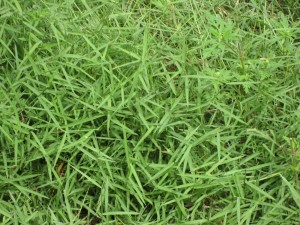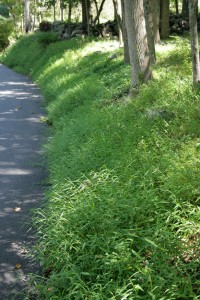Inside The New York Botanical Garden
Japanese stilt grass
Posted in Gardening Tips on September 20 2010, by Sonia Uyterhoeven
 |
Sonia Uyterhoeven is Gardener for Public Education. Join her each weekend for home gardening demonstrations on a variety of topics in the Home Gardening Center. |
 This past summer I attended a workshop given by NOFA Organic Land Care on the organic management of invasive plants in the landscape. I want to share some of the information I learned, especially as it relates to Japanese stilt grass (Microstegium vimineum), which I wrote about last week.
This past summer I attended a workshop given by NOFA Organic Land Care on the organic management of invasive plants in the landscape. I want to share some of the information I learned, especially as it relates to Japanese stilt grass (Microstegium vimineum), which I wrote about last week.
Since Japanese stilt grass is an annual grass, the primary goal is to prevent it from producing seeds. Let’s look at how to work with its life cycle in order to get rid of it.
Read More
Posted in Gardening Tips on September 13 2010, by Sonia Uyterhoeven
 |
Sonia Uyterhoeven is Gardener for Public Education. Join her each weekend for home gardening demonstrations on a variety of topics in the Home Gardening Center. |
 As I was walking into work recently, I bumped into Scott Mori, the Nathaniel Lord Britton Curator of Botany at the Garden. I mentioned to him that I had just attended a wonderful workshop given by NOFA Organic Land Care on the organic management of invasive plants in the landscape.
As I was walking into work recently, I bumped into Scott Mori, the Nathaniel Lord Britton Curator of Botany at the Garden. I mentioned to him that I had just attended a wonderful workshop given by NOFA Organic Land Care on the organic management of invasive plants in the landscape.
Scott mentioned that the biggest nuisance in his northern Westchester neighborhood is Japanese stilt grass (Microstegium vimineum). Approximately seven years ago he noticed a few plants along the roadside, several years latter the plants had formed a continuous band along each side of many of the roads, and today this pest is abundant in the woodland understory in his neighborhood. In addition, lawns are now also being invaded by this aggressive pest.
Japanese stilt grass is an annual grass indigenous to Japan, Korea, China, and India. It grows 2–3 feet tall and has a dense sprawling habit that gives it the capacity to smoother its neighbors. During the summer it colonizes an area by spreading along the ground via adventitious roots, which form from the nodes on its gangly stems.
Read More

 This past summer I attended a workshop given by NOFA Organic Land Care on the organic management of invasive plants in the landscape. I want to share some of the information I learned, especially as it relates to Japanese stilt grass (Microstegium vimineum), which I wrote about last week.
This past summer I attended a workshop given by NOFA Organic Land Care on the organic management of invasive plants in the landscape. I want to share some of the information I learned, especially as it relates to Japanese stilt grass (Microstegium vimineum), which I wrote about last week.
